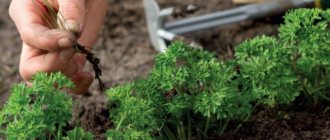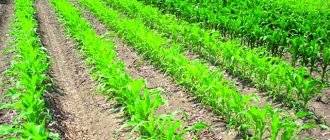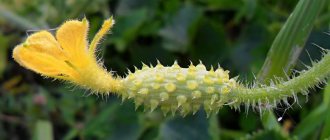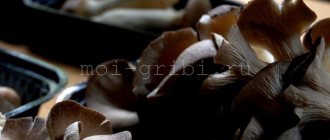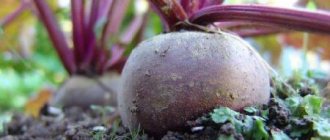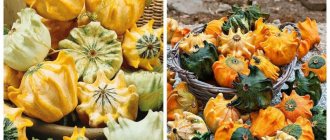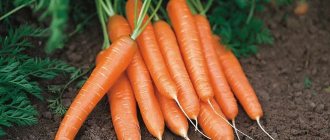What does it look like?
The root crop consists of an above-ground and underground part.
- Plant. The aerial part of the scorzonera, depending on the variety, reaches a height of 30 to 70 cm. The leaves have a dark green color. The leaf shape is ovoid or lanceolate. In May, flowers appear with a delicate vanilla scent. The inflorescences are large, formed from bright yellow cylindrical petals. The fruits of the inflorescences are the achene.
- Roots. The black cylindrical root has a succulent white interior. The length of the root crop is about 15 cm, diameter – 5 cm, weight – up to 150-200 grams.
Harvest and storage
Ripe root vegetables are harvested in the fall. You need to dig them up very carefully, because the roots are delicate and can be easily damaged. Preparing vegetables for storage:
- cleansing root crops from the ground;
- discarding damaged specimens;
- cutting off the tops.
It is recommended to collect root vegetables in small bundles of several pieces. You can't wash vegetables. The optimal place for storage is a basement or cellar. Root crops are placed vertically in a box and covered with earth. The room temperature should not rise above +10 °C.
Additional Information! If there is no cellar, you can store the harvest in the garden bed, burying it in the ground and covering it with a layer of about 20 cm of leaves on top.
Although scorzonera is not a carrot, both crops have identical planting rules and agricultural practices. Black root vegetables diversify the diet, add unusual, piquant notes to dishes, and benefit the body.
Where does it grow?
- In nature. The homeland of scorzonera is considered to be Egypt, Pakistan, India and Turkey. There are about 200 varieties and species of scorciera in nature. It grows in meadows and fields, often along roads. Wild varieties are inferior in taste and vitamin composition to their cultivated relatives.
- Self-grown. Scorzonera became widespread in the 17th - 18th centuries in France, Spain, Germany, and Portugal. The healing properties and taste quickly won the favor of citizens of Western European countries.
Reference! Currently, it is cultivated in many countries. In America for agricultural needs. In China it is grown for medicinal purposes. Black carrots are rarely found in Russian gardens. This is exotic for us.Few people know how to grow it properly. But, if the necessary conditions for growth are created in the southern regions, it is capable of producing a good harvest.
Places of growth
The homeland of the variety is the southern part of European territory and southwest Asia. Today, the plant is cultivated and distributed in different parts of the world: almost throughout Europe, including in areas from the countries of the eastern Mediterranean to East Asia. It is found in Georgian and Armenian cultivated areas; the vegetable is cultivated in Italy, France, Egypt, Turkey, Pakistan, the Netherlands, and Belgium.
Scorzonera is a typical representative of the vegetation of the steppe strip.
In Russia, black carrots are cultivated in the Republic of Dagestan, in the foothills of the Caucasus, at the foot of the Ural Mountains, right up to the border with Kazakhstan, in Western Siberia.
The vegetable prefers arid regions. In wild conditions it grows mainly on limestone soils, steppes and rocky slopes.
Under artificial conditions for growing seeds, greenhouses are suitable for cultivating vegetables. Cultivating scorzonera, which loves warm climates, with seeds and seedlings in open soil is difficult.
Among the varieties that have successfully taken root in private gardens are Spanish, Black Knight, and Lilac Dragon.
Benefits and harms
- The root vegetable has a healing effect on people who eat it. Improves metabolic processes. Increases immunity. Helps overcome various diseases.
- The plant contains inulin, which lowers cholesterol levels in the blood.
- A number of biologically active components improve the functioning of the heart, stomach, intestines and kidneys. Therefore, it is used for the production of medicines.
- Doctors recommend black root in the fight against excess weight, influenza and ARVI viruses, vitamin deficiency and anemia.
- It lowers blood pressure and fights inflammation.
- An effective antioxidant.
- It contains insulin, so the root vegetable is recommended for people with diabetes.
- Scorzonera contains a large amount of lutein, so it is used to improve vision.
- Scorzonera is able to cleanse the body of toxins and increase potency. Useful for people with alcohol addiction.
Contraindications:
- do not use if you have gastritis or gastric ulcer;
- Individual intolerance may occur;
- The root vegetable can cause a laxative effect.
Benefits of black carrots
The benefits of scorzonera have been studied since the time of Alexander the Great. In those days, it was a real delicacy, used not only in the preparation of various dishes, but also in medicines. So, what are the benefits of black carrots:
Since the time of Alexander the Great, black carrots have been used as a delicacy and medicine.
- It has a very rich composition including saccharides, vitamins (B1, B2, C, E), minerals (phosphorus, iron, calcium, etc.).
- This is a natural source of inulin - a substance that is necessary for diabetics. It also contains levulin and aspargine.
- This vegetable is very well absorbed by the body.
- Helps in the fight against vitamin deficiency, anemia, obesity, diabetes, influenza, ARVI and some other diseases.
- Black carrots are used to lower blood pressure and improve vision. It can also relieve inflammation in the body.
Important!
Scorzonera is especially useful for people who are prescribed a diet.
Varieties, their descriptions and places to purchase seeds
Varieties of black carrots available in Russia.
"Healing"
Mid-early variety. In the first year, it forms a rosette of large lanceolate leaves, reaching 30 - 35 cm. After overwintering in the ground, the roots reach their maximum size and weight up to 80 grams. The pulp is white, juicy, and has a sweetish, astringent taste. Healing properties are at their best. Ripening time is up to 120 days (read about carrot varieties with early ripening here). Specific taste similar to peanuts.
"Sunny Premiere"
An early variety with a vertical rosette composed of elongated ovate leaves. The root crop is dark brown in color and weighs up to 80 grams. Length up to 30 cm. Productivity is 1.5-2 kg per 1 sq. meters. Ripens in 110 days.
"Gypsy"
The root crop is black, cylindrical. Length 30 cm. Dietary grade for people with diabetes. In the first year of its two-year growing season, the plant grows a rosette of leaves. The pulp contains milky juice. It has a sweetish astringent taste. In the second year of growing season, the plant grows up to 1.5 meters and begins to branch. It blooms in the form of baskets of yellow flowers.
"Overseas delicacy"
Mid-season variety. The roots are cylindrical, dark brown. Length up to 35 cm. Weight 100-130 g. Leaves height up to 20 cm.
Important! They have dietary properties and are suitable for salads. Strengthen the immune system. Activate metabolism and lower cholesterol.
Productivity per 1 sq. m no more than 2 kg.
"Russian Giant"
Stem length up to 75 cm. Leaves oblong, ovate. High yield. The root vegetable is rich in vitamins, but unsaturated in taste.
In Moscow and St. Petersburg, seeds are purchased in specialized stores or ordered through online stores. A package weighing 0.5 g costs from 16 to 20 rubles.
Composition and scope of application
Unusual carrots
Black carrot root vegetables contain significant amounts of healthy substances, including:
- inulin from the group of polysaccharides,
- asparagine, which belongs to the group of amino acids,
- levulin.
Unlike classic carrots, black root vegetables have less beta-carotene in their chemical composition, which is compensated by the largest amount of alpha-carotene, anthocyanins, a large dose of antioxidants and lutein.
Cooking
Black carrots, along with white and orange, are widely used in cooking. It is used as a seasoning for first and second courses and as an additive to soft drinks and desserts. At the same time, the anthocyanins contained in black carrots provide the vegetable with coloring properties.
Medicine
Due to its high quality characteristics, black carrots are beneficial in dietary nutrition. It is especially useful for the elderly generation. Extracts with it are recommended for patients with diabetes mellitus and hypertension, gout and liver diseases.
Step-by-step instructions for growing
Growing black carrots is easier than regular carrots. Fertilized, well-dug soil in a sunny area is suitable for her. Otherwise, she is unpretentious.
Preparing for landing
- Inventory. To plant scorzonera in your garden plot you will need a shovel and a rake.
- Soils. The first step is to select a site. A sunny place where no root crops grew last season is suitable. The future bed is fertilized with organic or mineral fertilizers and dug to a depth of at least 25 cm. The root grows downwards and if the soil is dense it will bend or bifurcate. Neutral acidity of the soil is desirable.
- Semyon. You can sow freshly harvested seeds, but it is better if they are from last year. Before planting, they are soaked for 2 hours in water. The floating seeds are thrown away. The rest are laid out on wet paper or cloth for 2-3 days, maintaining humidity. Sprouted seeds are planted in the soil.
Dates and sowing pattern
- Landing dates. Scorzonera can be sown in early spring or late summer. The spring plantings are harvested in August. Winter plantings will ripen next season, at the beginning of summer.
- Scheme. When planting on 1 sq.m. 2 grams of seeds are required. The sprouted seeds are placed in furrows about 1.5 cm deep. The soil is compacted. The distance from each other is 5 cm, between the rows up to 30 cm. With thickened plantings, black carrots go into the arrow.
Care
The first shoots appear after 7-10 days. A few days after germination, the plants are thinned out, leaving gaps of 10-12 cm.
- Watering. Water the black root 2-3 times a week. Dry soil makes the roots coarse and fibrous.
- Feeding:
- wood ash 2 cups per 7 liters of water;
- nitrophoska 1 tablespoon per 7 liters of water;
- solution of superphosphate, urea, potassium nitrate 15 g x 15 g x 20 g x 7 l of water.
- Loosening. Loosen the soil after germination and as the crust dries. To avoid loosening, mulch.
- Weeding. Scorzonera must be weeded periodically, otherwise the vegetables will grow thin and too long.
- Mulching. After the seeds germinate, you need to loosen the soil. So we fluff up the crust formed from watering. To prevent the soil from drying out in the future, it is mulched. To do this, scatter sawdust, chopped grass, and used tea leaves over the surface.
There are a great many varieties of carrots. Our experts have prepared materials about Dutch varieties, Flakka, Children's sweetness, as well as purple, white, yellow varieties.
Harvesting and storage
For selective consumption, the black root is dug up 100-120 days after germination.
But for storage, cleaning is carried out before the onset of frost. The root must be removed carefully so as not to damage it. The tops must be removed and the root crop dried. In the southern regions, scorzonera is partially left to overwinter, dug up as needed. Whole roots are selected for storage. They try to use damaged carrots immediately.
Attention! The black root is placed vertically, sprinkled with wet sand and left at a temperature of 0 to 3 degrees.
What difficulties may there be when growing
A gardener who has dealt with carrots can handle scorzonera.
Possible difficulties during cultivation may include :
- Low seed germination. Already in the second year they are almost unsuitable for sowing. Therefore, only fresh ones should be planted.
- Excessive soil moisture. Drainage should be done - or take into account the mistake and sow the seeds in a different place next year.
Otherwise, this crop is unpretentious and requires almost no special care in summer.
Disease and pest control
- White and gray rot form on the stem and leaves in the form of plaque. Regular loosening of the soil and spraying with copper sulfate will protect against the occurrence of this disease.
- When a vegetable is infected with black rot, the tops of the stems curl and yellow spots form on the leaves. To combat the disease, the drug “Rovral” is used.
- Brown spotting is characterized by the appearance of light yellow spots. A decoction of nettle or horsetail, which is sprayed on the plant, can help prevent the disease.
- Cercospora blight appears as gray spots on the leaves. In this case, Bordeaux mixture will come to the rescue.
Insect pests have a detrimental effect on the crop . Here are some of them:
- psyllids;
- mole;
- nematodes;
- bear
Methods for treating beds against pests:
- For moths , spray with a decoction of tomato stems.
- For psyllids - soapy water.
- For nematodes they are treated with Dekaris.
- To combat mole crickets, pour a solution of vinegar (a tablespoon in a bucket of water) or water with washing powder into the minks.
How and where it is used
The use of scorzonera is divided into two large groups:
- as a food plant;
- as a natural cure for diabetes.
To treat diabetes, the roots are used raw : they can be chewed, or you can, for example, finely chop or grate them and add sunflower or olive oil to make a salad.
As for cooking, black carrots are used:
- For seasoning soups. In this case, it is cleaned, cut into cubes and added shortly before readiness.
- As a side dish for meat or fish. Usually, for this, the roots are lightly boiled and added to the main dish.
- As an ingredient in drinks. Scorzonera juice gives them an original flavor and shade.
- In raw form - for salads.
Tender young leaves can also be used in salads .
Methods of use
The pulp of the vegetable is juicy with the smell of vanilla. The root vegetable can be chewed raw. It tastes similar to sweet radish or asparagus. When cooked, it acquires a unique taste. It is added to soups, salads, and main courses. In terms of nutritional value, it can replace meat and fish dishes, nuts.
Scorzonera is not yet a full-fledged product in Russia. But, she deserves a worthy place on our tables. The great benefits of the root vegetable and its taste will do the trick. And we must hope that soon it will become as common in our diet as its orange brother.
If you find an error, please select a piece of text and press Ctrl+Enter.
Using black carrots
We recommend reading our other articles
- The best blue grape varieties with descriptions and photos
- Chicken coop litter with bacteria
- How to feed peonies in spring?
- How to water an orchid
Delicious cream soup with black carrots, pine nuts and seeds
Black carrots are used primarily in cooking and in folk medicine. It is consumed raw, peeled and seasoned with vegetable oil. Suitable for making desserts, snacks, juice, stewing, frying, boiling, freezing and even canning. The root vegetable of this plant is most often eaten, but young greens are also edible. She is used to prepare salads.
This vegetable goes well with meat, fish and a wide variety of vegetables and herbs. It adds a pleasant aroma to first courses, and improves color in desserts like jelly.
The aroma of the pulp is slightly vanilla. Black carrots do not taste as sweet as plain orange ones, even if they are cared for according to all the rules. The taste is bitter, but with sweet notes, and can be spicy in places. Experts compare it to black radish or asparagus.
Appearance of the root vegetable
Typically this carrot variety is perennial, but gardeners plant it for two years. In the first year, part of the black carrots is dug up and both the tops and roots are eaten. Rosettes of leaves are added to a variety of salads, and the roots are used in the same way as orange carrots - when preparing first and second courses, they are added to salads. In the second year, scorcieria blooms; its fragrant flowers of bright yellow color cannot be confused with any others. By autumn, instead of flowers, seeds remain, suitable for subsequent sowing.
Wild relatives of black carrots are also found in nature in the countries of the Middle East and Asia, but cultivated varieties of scorcieria are much tastier and juicier. The root crops of varieties of this vegetable grown in gardens are about 30 cm in length and their thickness is about 40 mm. What do black carrots look like? The photos in the article show us that the peel is black, and the flesh of such carrots can be completely white or two-colored (dark edges and light center). It all depends on the variety. It has the same density as its orange relative from European countries. But the smell of this vegetable crop is more pleasant and somewhat reminiscent of vanilla.
Carrots: description of the 28 best varieties, characteristics (Photo & Video) | +Reviews
Carrots currently have many varieties and subspecies; descriptions of all its varieties take up more than one thousand pages. This is one of the most popular plants grown by mankind.
Its importance for the diet was noticed in ancient times: according to historical research, humanity began to grow carrots more than four and a half thousand years ago.
Features of growing the variety
Among the most unpretentious vegetables, black carrots occupy a leading position. It is usually planted in an area that is not suitable for growing other crops or next to other perennials. Before planting, it is advisable to fertilize the soil with wood ash or minerals. Thus, it is possible to increase the germination of the plant and improve its nutritional properties. But humus or manure cannot be added before sowing black carrots!
Sow scorzonera in spring, summer or autumn - when convenient.
Among the most unpretentious vegetables, black carrots occupy a leading position
- When planted in spring, the harvest is obtained in the same year. The seeds are soaked and sown from the end of April. It is recommended to cover the crops with film so that the seeds germinate faster.
- If you sow the crop in summer, it will be grown as a biennial plant. In summer, fresh seeds collected in the same year or last year are sown. In summer and autumn, such a plant will develop, then overwinter, and in the spring or next summer it will produce roots and seeds.
- Fall planting allows for a harvest the following year, a few weeks earlier than spring-planted black carrots.
The first shoots of black carrots appear after 2 weeks or even earlier. When 2-3 leaves appear, you can thin out the plantings so that there is about 15 cm of free space between plants. When the sprouts reach 7 cm in height, the ground under them is mulched with peat or straw. If this is not done, frequent weeding will be required.
After ripening (100-120 days on average), the crop is harvested and stored. You need to be careful when digging - this vegetable is more brittle than simple carrots! To keep it longer, you can put it in the refrigerator or in a cool basement if it’s dry there.
The main advantages and disadvantages of the type
Advantages of black carrots over other root vegetables:
- Original taste, rich in minerals.
- Scorzonera is indispensable for diabetics due to the plant levulin it contains.
- Possibility of eating not only roots, but also leaves.
- Unpretentiousness. Scorzonera is not too demanding on soil composition and frequent watering, although it does require some care.
- Pest resistance.
